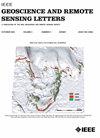Removal of Co-Frequency Powerline Harmonics From Multichannel Surface NMR Data
IF 4
3区 地球科学
Q2 ENGINEERING, ELECTRICAL & ELECTRONIC
引用次数: 19
Abstract
Powerline harmonics are often the primary noise source in surface nuclear magnetic resonance (NMR) measurements. State-of-the-art techniques, such as notch filtering, Wiener filtering, and model-based subtraction, have been demonstrated to greatly mitigate powerline harmonic noise, but these approaches break down when one of the powerline harmonics has a frequency close to or coincident with the Larmor frequency $f_{L}$ , referred to as a co-frequency harmonic. We propose a hybrid scheme where model-based subtraction of powerline harmonics is coupled with data from a synchronous reference coil to specifically subtract the co-frequency harmonic component. In standard model-based subtraction of powerline harmonics, a sinusoidal model of all harmonic components is fit to the data and subtracted. In the new approach, the amplitude and phase of the co-frequency harmonic are determined by a sinusoidal model fit to the synchronous noise-only data recorded in a reference coil. From the reference coil co-frequency model, the co-frequency harmonic in the primary coil is estimated using relationships between the amplitude and phase of the co-frequency harmonic in the two coils established during noise-only segments. By utilizing data from the reference coil to model the co-frequency harmonic, accidental fitting of the surface NMR signal is avoided. We investigate the efficiency of the method using a synthetic surface NMR signal embedded in noise-only data recorded in Denmark. Our results demonstrate that the co-frequency powerline harmonic can be removed efficiently without distorting the surface NMR signal and the new method performs better than standard methods.从多通道表面核磁共振数据中去除共频电力线谐波
电力线谐波通常是表面核磁共振(NMR)测量中的主要噪声源。最先进的技术,如陷波滤波、维纳滤波和基于模型的减法,已经被证明可以极大地减轻电力线谐波噪声,但是当电力线谐波中的一个频率接近或与拉莫尔频率$f_{L}$(称为共频谐波)一致时,这些方法就会失效。我们提出了一种混合方案,其中基于模型的电力线谐波减法与来自同步参考线圈的数据相结合,以具体减去共频谐波分量。在基于标准模型的电力线谐波减法中,所有谐波分量的正弦模型与数据拟合并相减。在新方法中,共频谐波的幅值和相位由与参考线圈中记录的同步噪声数据拟合的正弦模型确定。根据参考线圈共频模型,利用在噪声段期间建立的两个线圈共频谐波的幅值和相位之间的关系估计初级线圈中的共频谐波。利用参考线圈的数据对共频谐波进行建模,避免了表面核磁共振信号的意外拟合。我们使用在丹麦记录的噪声数据中嵌入的合成表面核磁共振信号来研究该方法的效率。结果表明,该方法可以有效地去除共频电力线谐波,而不会使表面核磁共振信号失真,且性能优于标准方法。
本文章由计算机程序翻译,如有差异,请以英文原文为准。
求助全文
约1分钟内获得全文
求助全文
来源期刊

IEEE Geoscience and Remote Sensing Letters
工程技术-地球化学与地球物理
CiteScore
7.60
自引率
12.50%
发文量
1113
审稿时长
3.4 months
期刊介绍:
IEEE Geoscience and Remote Sensing Letters (GRSL) is a monthly publication for short papers (maximum length 5 pages) addressing new ideas and formative concepts in remote sensing as well as important new and timely results and concepts. Papers should relate to the theory, concepts and techniques of science and engineering as applied to sensing the earth, oceans, atmosphere, and space, and the processing, interpretation, and dissemination of this information. The technical content of papers must be both new and significant. Experimental data must be complete and include sufficient description of experimental apparatus, methods, and relevant experimental conditions. GRSL encourages the incorporation of "extended objects" or "multimedia" such as animations to enhance the shorter papers.
 求助内容:
求助内容: 应助结果提醒方式:
应助结果提醒方式:


